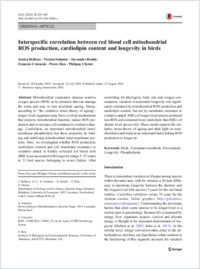Interspecific correlation between red blood cell mitochondrial ROS production, cardiolipin content and longevity in birds.
- Delhaye J Department of Ecology and Evolution, Quartier Sorge, bâtiment Biophore, University of Lausanne, 1015, Lausanne, Switzerland. jessica.delhaye@live.fr.
- Salamin N Department of Ecology and Evolution, Quartier Sorge, bâtiment Biophore, University of Lausanne, 1015, Lausanne, Switzerland.
- Roulin A Department of Ecology and Evolution, Quartier Sorge, bâtiment Biophore, University of Lausanne, 1015, Lausanne, Switzerland.
- Criscuolo F IPHC, UNISTRA, CNRS, 23 rue du Loess, 67200, Strasbourg, France.
- Bize P Department of Ecology and Evolution, Quartier Sorge, bâtiment Biophore, University of Lausanne, 1015, Lausanne, Switzerland.
- Christe P Department of Ecology and Evolution, Quartier Sorge, bâtiment Biophore, University of Lausanne, 1015, Lausanne, Switzerland.
- 2016-08-31
Published in:
- Age (Dordrecht, Netherlands). - 2016
Birds
Comparative methods
Free radicals
Longevity
Phospholipids
Aging
Animals
Birds
Body Weight
Cardiolipins
Erythrocytes
Longevity
Mitochondria
Mitochondrial Membranes
Oxidative Stress
Oxygen Consumption
Phylogeny
Reactive Oxygen Species
English
Mitochondrial respiration releases reactive oxygen species (ROS) as by-products that can damage the soma and may in turn accelerate ageing. Hence, according to "the oxidative stress theory of ageing", longer-lived organisms may have evolved mechanisms that improve mitochondrial function, reduce ROS production and/or increase cell resistance to oxidative damage. Cardiolipin, an important mitochondrial inner-membrane phospholipid, has these properties by binding and stabilizing mitochondrial inner-membrane proteins. Here, we investigated whether ROS production, cardiolipin content and cell membrane resistance to oxidative attack in freshly collected red blood cells (RBCs) are associated with longevity (range 5-35 years) in 21 bird species belonging to seven Orders. After controlling for phylogeny, body size and oxygen consumption, variation in maximum longevity was significantly explained by mitochondrial ROS production and cardiolipin content, but not by membrane resistance to oxidative attack. RBCs of longer-lived species produced less ROS and contained more cardiolipin than RBCs of shorter-lived species did. These results support the oxidative stress theory of ageing and shed light on mitochondrial cardiolipin as an important factor linking ROS production to longevity.
- Language
-
- English
- Open access status
- green
- Identifiers
-
- DOI 10.1007/s11357-016-9940-z
- PMID 27572896
- Persistent URL
- https://folia.unifr.ch/global/documents/100250
Statistics
Document views: 14
File downloads:
- fulltext.pdf: 0
